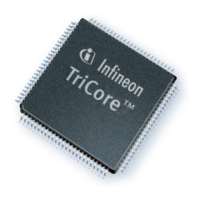TriCore
®
TC1.6P & TC1.6E
32-bit Unified Processor Core
Instruction Set Overview
V1.0 2013-07
User Manual (Volume 2) 2-17
Both the 24-bit and 8-bit relative displacements are scaled by two before they are used, because all instructions
must be aligned on an even address. The use of a 24-bit field as an absolute address is shown in Figure 2-16.
Figure 2-16 Calculation of Absolute Address
2.9.2 Conditional Branch
The conditional branch instructions use the relative addressing mode, with a displacement value encoded in 4, 8
or 15-bits.
The displacement is scaled by 2 before it is used, because all instructions must be aligned on an even address.
The scaled displacement is sign-extended to 32-bits before it is added to the program counter, unless otherwise
noted.
Conditional Jumps on Data Registers
Six of the conditional jump instructions use a 15-bit signed displacement field:
• JEQ (Comparison for Equality)
• JNE (Non-Equality)
• JLT (Less Than)
• JLT.U (Less Than Unsigned)
• JGE (Greater Than or Equal)
• JGE.U (Greater Than or Equal Unsigned)
The second operand to be compared may be an 8-bit sign or zero-extended constant. There are two 16-bit
instructions that test whether the implicit D[15] register is equal to zero (JZ) or not equal to zero (JNZ). The
displacement is 8-bit in this case.
The 16-bit instructions JEQ and JNE compare the implicit D[15] register with a 4-bit, sign-extended constant. The
jump displacement field is limited to a constant for these two instructions.
There is a full set of 16-bit instructions that compare a data register to zero; JZ, JNZ, JLTZ, JLEZ, JGTZ, and
JGEZ.
Because any data register may be specified, the jump displacement is limited to a 4-bit zero-extended constant in
this case.
Conditional Jumps on Address Registers
The conditional jump instructions that use address registers are a subset of the data register conditional jump
instructions. Four conditional jump instructions use a 15-bit signed displacement field:
• JEQ.A (Comparison for Equality)
• JNE.A (Non-Equality)
• JZ.A (Equal to Zero)
• JNZ.A (Non-Equal to Zero)
Because testing pointers for equality to zero is so frequent, two 16-bit instructions, JZ.A and JNZ.A, are provided,
with a displacement field limited to a 4-bit zero extended constant.
TC1059B
2019
0
20
0
24 bit field
from
Absolute
instruction
0
Address
23
21
0000000
2728
31
1

